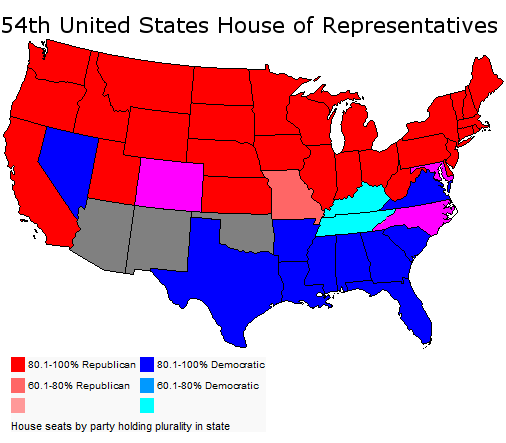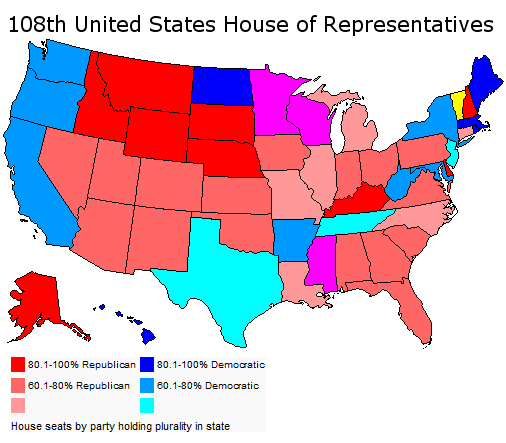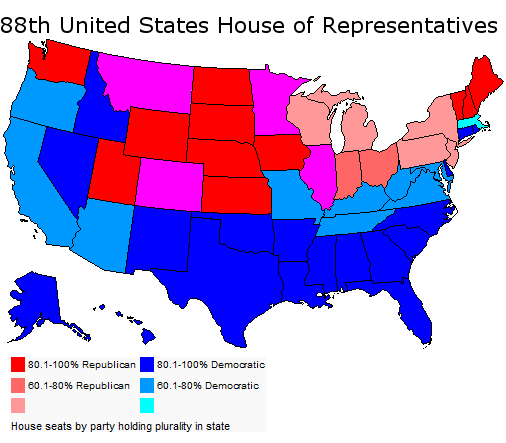A number of commentators have lamented increasing polarization in Washington. Conventional wisdom has it that America is as divided and partisan as it ever has been. Sectional divisions are tearing this country apart and preventing problems such as the deficit from being addressed; the differences between blue America and red America, in this view, are rapidly approaching crisis point.
There is some justice to this view. Polarization has probably increased, by a number of metrics, over the past few elections. Indeed, I previously noted something to this exact effect.
Let’s take another look, however, at the hypothesis, using a different type of measurement. Do blue states elect Republican representatives, and vice versa? In a polarized nation, this would probably not be the case.
Here is the House today:
As this stark contrast illustrates, perhaps polarization ain’t so bad as it used to be.
More below.
The 2008 image is a fascinating map in that it almost perfectly matches the 2008 electoral college. One sees the Republican corridor of strength in the South and Mountain West. Most of the map is blue since Democrats have a 255-178 majority, the result of two previous Democratic landslides.
Here is a map of a House with a Republican majority:
This House was the result of 2002 congressional elections. Republicans had done well in the wake of 9/11, and they had a 232-201 majority.
In the map there are relatively few states with 80-100% of representatives from one party. Blue states elect Republicans; red states elect Democrats. Moreover; for some states (e.g. Delaware, the Dakotas) it is mathematically impossible to be less than 100% Democratic or Republican.
Let’s move back several decades:
The date is 1960; President John Kennedy has just been elected. Democrats hold a 258-177 majority, almost identical to that today.
There are a lot more “one-party states” compared to the current map. Sectional division is far more pronounced; there is a line between North and South that simply does not exist in today’s House. In 1960 – especially in the still-standing Solid South – blue states generally did not elect Republicans, and vice versa.
Polarization grows even worse if one goes back further. Here is 2002, once again:
Republicans have just won 130(!) seats. They hold a 254 to 93 majority.
In this incredible map, there are only six states with congressional delegations less than 80-100% from one party. In it one can literally trace the battlefields of the Civil War.
This is real polarization, the results of a nation so divided it had literally torn itself in two. This is the type of polarization that results from scars so deep that they took more than a century to heal.
Perhaps today America is indeed growing more polarized, more divided into red states and blue states. But when one compares the present situation to past ones, there is literally no comparison. The United States has a long way to go before it gets as polarized as it did during the latter half of the 19th century.
–Inoljt, http://mypolitikal.com/




Has given way to party polarization. Biggest difference between 1894 and today being far fewer conservative Democrats and hardly any liberal Republicans.
Is so misleading.
Why have all the plains states remained Republican for so long (Nebraska, Kansas, the Dakotas, etc)?
I know the Republican Party way back when was considered the more progressive of the two party system (I know its probably more complex than that, but work with me here). Now that the binary has changed, they still vote Republican. I also remember reading about how North Dakota NPL politicians from that era had a lot of ideas that could be construed as pure socialism, but now the state votes Republican by default.
Does anyone here have insight into this?